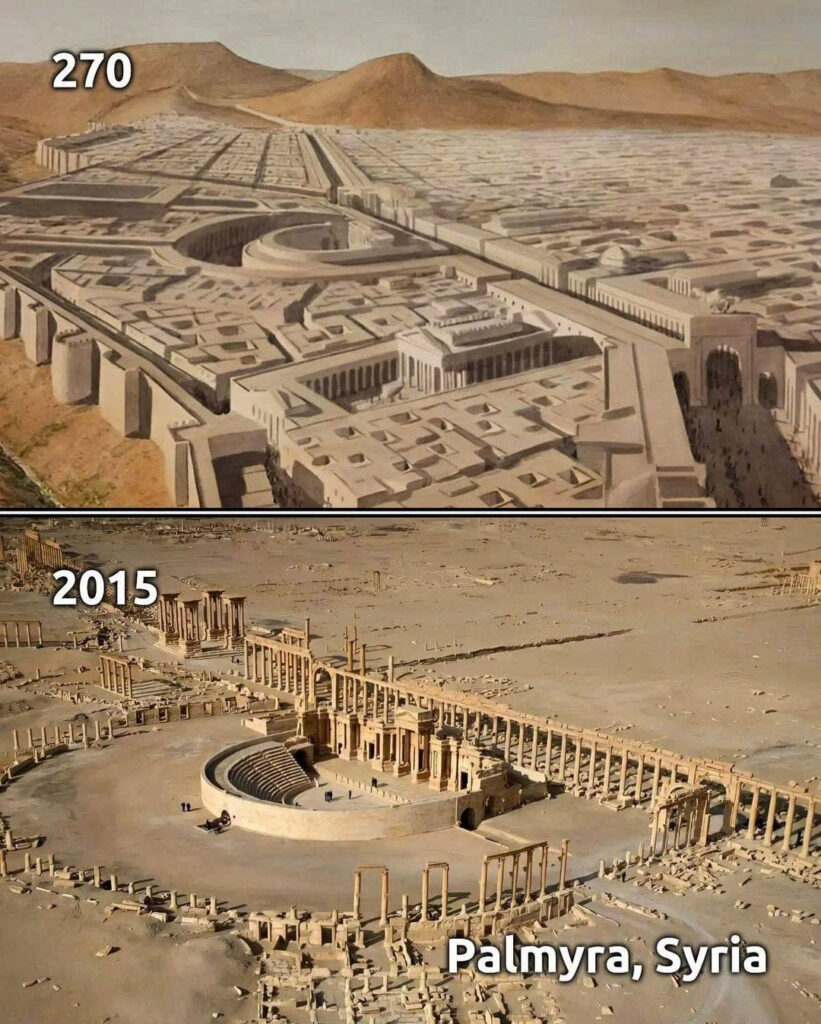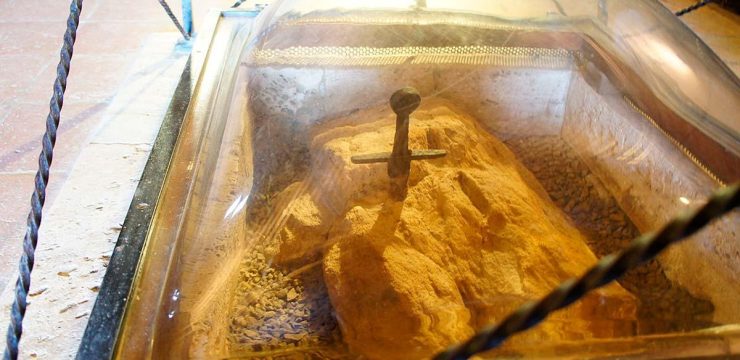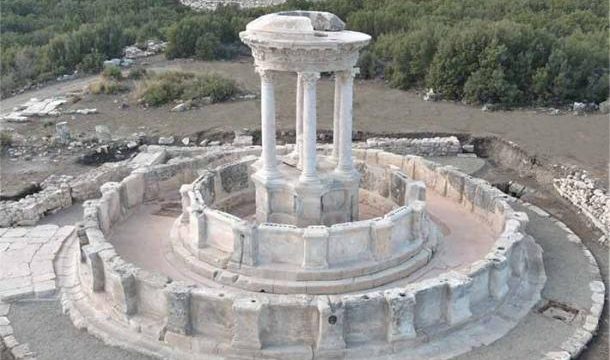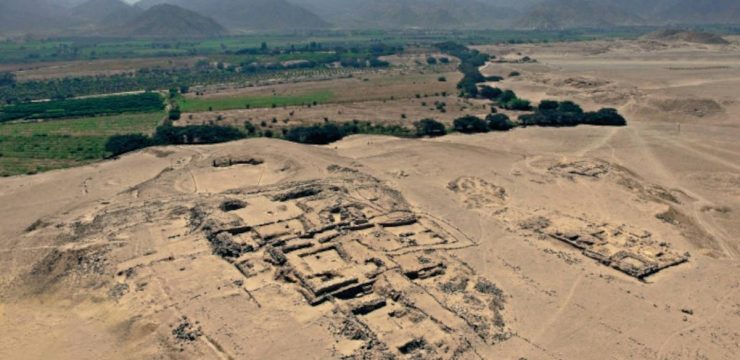Deep in the heart of Syria, approximately 130 miles northeast of Damascus, lies an ancient city whose history is as compelling as the ruins that remain. Known in antiquity as Tadmur, this oasis in the vast Syrian desert would eventually rise to prominence as Palmyra, a name given by the Romans in the 1st century CE, meaning “city of palm trees.” While today it stands in silent decay, its past tells a story of resilience, commerce, and architectural grandeur that once made it one of the most important trade and cultural centers in the ancient world.

Palmyra’s strategic location played a defining role in its rise to greatness. Situated between the Mediterranean Sea and the Euphrates River, it became a crucial point of convergence for merchants navigating the vast trade routes that linked the Roman Empire, Mesopotamia, Persia, and beyond. Unlike many other ancient cities that owed their prosperity to fertile land or access to abundant water sources, Palmyra thrived in the arid desert due to its unparalleled role as a crossroads of civilizations. Its position allowed it to grow from a modest desert settlement into a powerful and wealthy metropolis, where commerce flourished and cultures intermingled.
The transformation of Palmyra from a remote oasis to a bustling urban center was nothing short of extraordinary. By the 3rd century BCE, its reputation as a commercial hub had spread far and wide. Merchants and caravans laden with spices, silk, incense, ivory, and precious metals passed through its streets, turning the city into a melting pot of traditions, religions, and artistic influences. The exchange of goods was accompanied by an equally important exchange of ideas, as the city became a conduit for knowledge, philosophy, and technological advancements between the East and the West. Greek, Roman, and Persian influences blended seamlessly with the local Aramean and Semitic traditions, giving Palmyra a unique cultural identity.
Palmyra’s prosperity was evident in its breathtaking architecture, which rivaled that of any great ancient city. The ruins that remain today, though weathered by time and human conflict, still speak to the city’s former grandeur. Among the most remarkable structures was the Temple of Bel, a massive religious complex dedicated to one of the most revered deities in the region. With its towering columns and intricate carvings, the temple stood as a testament to the architectural sophistication of Palmyra’s builders. The Great Colonnade, an awe-inspiring avenue lined with monumental columns stretching for more than a mile, connected many of the city’s most significant buildings, showcasing the city’s urban planning and engineering prowess.
Perhaps one of the most iconic features of Palmyra was the grand Arch of Triumph, which once greeted visitors entering the city. This triumphal arch, adorned with exquisite reliefs, symbolized the city’s strength and prestige. It was a gateway not just to a city but to a civilization that prided itself on cultural refinement, economic power, and artistic expression. The Theater of Palmyra, another striking landmark, reflected the city’s appreciation for entertainment and the arts, hosting performances that captivated audiences and reinforced the city’s role as a cultural beacon in the region.
Despite its success, Palmyra’s fortunes were not without challenges. The city found itself caught in the power struggles between the Roman Empire and the Persian Sassanids. Under the leadership of the legendary Queen Zenobia in the 3rd century CE, Palmyra briefly asserted its independence, challenging Roman authority and establishing itself as a regional power. Zenobia, an ambitious and highly educated ruler, expanded Palmyra’s influence, even conquering parts of Egypt and Anatolia. Her defiance, however, led to her downfall, as the Roman Emperor Aurelian ultimately defeated her forces and brought Palmyra back under imperial control. The city never fully recovered from this defeat, and its decline had begun.
Over the centuries, Palmyra faced waves of invasions, conquests, and natural disasters that eroded its prominence. Yet, even as its political and economic influence waned, its cultural and historical significance endured. The city continued to be a vital stop along trade routes, albeit with diminished power. As centuries passed, it gradually fell into obscurity, abandoned to the sands of the Syrian desert.
In modern times, Palmyra has fascinated archaeologists, historians, and travelers alike. Excavations have uncovered remarkable artifacts that offer insight into the lives of the people who once called the city home. Inscriptions in multiple languages—including Greek, Latin, Aramaic, and Persian—reflect the city’s diverse population and its role as a bridge between different civilizations. The discovery of beautifully crafted statues, intricate mosaics, and funerary towers further illuminates the artistic and spiritual life of the Palmyrenes.
Despite its remarkable resilience through the ages, Palmyra has also suffered from the destructive forces of modern conflict. In recent years, war and deliberate acts of vandalism have severely damaged some of its most iconic structures, leading to an outcry from the global archaeological community. Efforts to document, restore, and preserve what remains have intensified, driven by the understanding that Palmyra’s ruins are not just relics of a lost city but symbols of humanity’s shared heritage.
Today, the remnants of Palmyra stand as a haunting yet majestic reminder of its former glory. Visitors who walk among its fallen columns and weathered stone facades can still feel the echoes of its vibrant past. They can imagine the bustling markets, the grand processions, and the scholarly debates that once filled its streets. The city’s legacy is one of endurance and brilliance—a testament to the ingenuity of the people who built it and the civilizations that shaped it.
Palmyra’s story is a powerful narrative of ambition, resilience, and cultural synthesis. From its beginnings as a desert oasis to its emergence as a thriving commercial and cultural powerhouse, it remains a source of fascination and inspiration. Even in ruins, its allure is undiminished, serving as a poignant reminder of the transient nature of human civilization and the timeless value of history. Palmyra’s ruins, though battered by time and conflict, continue to speak across the centuries, inviting us to remember, to learn, and to marvel at the achievements of those who came before us.





